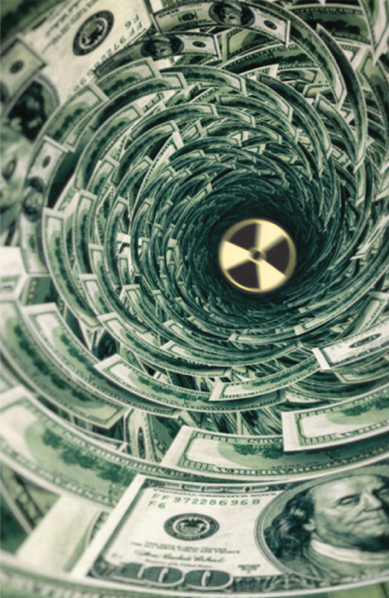
Last week President Biden sent his Fiscal Year 2025 budget request to Congress. While this general fact made the news; many media outlets failed to highlight that the U.S. military defense budget for the coming fiscal year is approaching a trillion dollars. The President’s FY25 request stands at $895 billion for the Defense Department and the nuclear weapons in the Department of Energy’s National Nuclear Security Administration (NNSA).
Congress will debate the budget in committee and on the floor in the coming weeks and months. If the past is prologue, while many social programs will be on Congress’s chopping block, a plethora of weapons systems including new nuclear warheads will be increased well over the President’s already obscene request.
Tri-Valley CAREs is committed to ensuring this madness does not happen on the quiet, without public outcry and opposition. To help inform your activism, this alert summarizes key information from the President’s request for the National Nuclear Security Administration, with a focus on its nuclear weapons activities.
Between now and October 1, 2024 (which begins fiscal 2025) we will offer a series of action alerts and opportunities for your voice to be heard alongside other Tri-Valley CAREs members, colleagues, and allies from like-minded organizations. We invite your participation!
The White House statement touts its FY25 request for “$19.8 billion for Weapons Activities, $4.5 billion above the 2021 enacted level.” This is the lion’s share of the total NNSA request, which stands at $24.9 billion for FY25. (See, for example, NNSA Vol. 1)
While the missiles and submarines over at the Pentagon cost more to build, it’s the NNSA nuclear Weapons Activities budget line that funds the warheads and bombs that arm them, making them weapons of nuclear mass destruction.
Here are some of the important NNSA details for the coming fiscal year:
First, the good news. The President’s FY25 budget request, once again, does not request any funding for a new nuclear version of the Sea-Launched Cruise Missile (W80-4Alt-SLCM). Biden’s nuclear posture review did not include it, and neither has any of his budget requests. Still, Congress has added money the last two budget cycles for this new warhead, which Livermore Lab is designing. So, we are calling on Congress to fund the new SLCM warhead in FY25 at the President’s request – zero dollars.

Unfortunately, the good news ends there. The President FY25 request funds six nuclear weapons systems overall, including
- the W80-4 warhead that Livermore is designing for a new air-lauched cruise missile, called the Long-Range Stand Off Weapon because pilots will be able to launch a precision-guided nuclear strike on an unsuspecting population from more than a thousand miles away;
- the W87-1 warhead, also being designed at Livermore Lab, which will be the first wholly new warhead developed since the end of full-scale nuclear testing in Nevada in 1992, and will require new plutonium pits (cores);
- the W93 warhead, which is in an early stage of development but is touted as a totally new design being done in cooperation with the United Kingdom to upgrade its nuclear fleet; and
- the B61-13 nuclear bomb, slated to begin its initial design in FY25.
The numbers tell the story. The FY25 request for the W80-4 is $1.2 billion, up 4% from 2023. The W87-1 request is $1.1 billion for FY95, up 61% from 2023. The W93 request is $456 million, up 90% from 2023. And, the B61-13 request in its first year is $16 million. Typically, as you can see from the list, initial requests start low and go up, up, up as the design work progresses.
(Related, Tri-Valley CAREs recently published its analysis of the design issues at Livermore Lab that are causing delays to the W80-4 and the W87-1, which we believe may increase costs in the coming years. CLICK here for that information.)
The NNSA FY25 request also contains a budget line for nuclear weapons dismantlement, which funds the work at the Pantex Plant to take apart nuclear weapons that have been retired previously and have been waiting in the dismantlement queue. This is a budget line that illuminates the relative priority being given to disarmament vs. armament. The request for the coming fiscal year stands at a paltry $54 million. Further, Congress does not tend to plus up this budget line one penny.
It’s up to us to make our voices – and our priorities – heard. While we hold the President accountable for his FY25 request, it is just that, a request. The Constitution gives Congress the power of the purse. Congress authorizes spending levels and appropriates funds for them. Further, we do have congressional champions who are trying to change U.S. nuclear policy and cut the budget. Congress needs to know that there is a public that cares about nuclear weapons issues.
Call or write your Senators and Representative today. The capitol switchboard is (202) 224-3121. Use one or two salient facts from this alert. Let them know you want less – not more – spending on nuclear weapons. Be sure to say you are a constituent and that you wish to be kept informed of the Senator or Representative’s actions on nuclear weapons throughout the budget cycle.
Further, when you call your Representative, ask that they co-sponsor H.Res.77, titled, “Embracing the Goals of the Treaty on the Prohibition of Nuclear Weapons.” This House Resolution currently has 42 cosponsors. Check here for the latest co-sponsors, and if your Rep. is already on the list, please thank them.
Together we can act to uphold Dr. King’s legacy and defy the “spiritual death” he decried, make “good trouble” to honor John Lewis, carry the torch forward as Daniel Ellsberg asked of us, and make a truly positive difference in our collective future.
Additionally, Please Stay Tuned to Our Electronic Newsletters and Website!
Analyses and action alerts on the FY25 request for NNSA plutonium and uranium bomb plants and the FY25 request for the Livermore Lab will follow shortly. So, too, will information about this spring’s Alliance for Nuclear Accountability DC Days and your Tri-Valley CAREs team that will travel to Washington to carry these recommendations into scores of meetings with members of Congress and administration officials. And, yes, there will be specific, creative actions you can take to amplify the message.